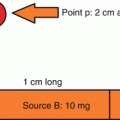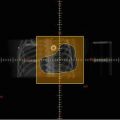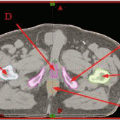(1)
University of Miami Sylvester Cancer Center, Miami, Florida, USA
Radiobiology is the study of how ionizing radiation affects living cells. This is extremely important in radiation therapy as the decision to use a particular treatment strategy is closely related to radiobiology.
The purpose of radiotherapy is to kill the cancer cells using ionizing radiation while minimizing normal tissue complications. The theoretical basis to accomplish this goal stems from how normal tissue and tumor tissue respond to radiation. Readers are expected to understand cell survival curves, cell cycles, and the mechanism of cell death by radiation and other factors related to cell death such as hypoxia.
6.1 Cellular Biology (Questions)
Quiz-1 (Level 2)
1.
The main constituent(s) of a cell is/are:
A.
I, II, and III
B.
I and III only
C.
II and IV only
D.
IV only
E.
All are correct
I.
Cytoplasm
II.
Parenchyma
III.
Nucleus
IV.
Stroma
2.
Human cells are:
A.
I, II, and III
B.
I and III only
C.
II and IV only
D.
IV only
E.
All are correct
I.
Eukaryotic cells
II.
Somatic cells
III.
Germ cells
IV.
Prokaryotic cells
3.
Which of the following is the definition of a mature cell?
A.
Cells which exist to self-perpetuate and produce cells for a differentiated cell population
B.
Cells which are fully differentiated and do not exhibit mitotic activity
C.
Cells which are in movement to another population
D.
Cells that divide and reproduce abnormally with uncontrolled growth
4.
Which of the following cells are classified as mature cells?
A.
Mucosa lining of the intestine
B.
Reticulocyte that is differentiating to become erythrocyte
C.
Epidermis
D.
Nervous tissue
5.
A group of cells that together perform one or more functions is referred as:
A.
Organ
B.
Organism
C.
Tissue
D.
Organ system
6.
The cell cycle is composed of:
A.
I, II, and III
B.
I and III only
C.
II and IV only
D.
IV only
E.
All are correct
I.
G1 or gap 1
II.
S or synthesis
III.
G2 or gap 2
IV.
M or mitoses
7.
In which part of the cell cycle do chromosomes separate and cell division takes place?
A.
Gap 1
B.
Synthesis
C.
Gap 2
D.
Mitoses
8.
The cell cycle in mammalian cells takes approximately:
A.
5 days
B.
10 days
C.
10–20 h.
D.
2 days
9.
Cells are most radiosensitive in:
A.
I, II, and III
B.
I and III only
C.
II and IV only
D.
IV only
E.
All are correct
I.
M phase
II.
S phase
III.
G2 phase
IV.
G1 phase
10.
Cells are most radioresistant in:
A.
I, II, and III
B.
I and III only
C.
II and IV only
D.
IV only
E.
All are correct
I.
M phase
II.
G1 phase
III.
G2 phase
IV.
S phase
11.
The biological effects of radiation result mainly from:
A.
Damage to the cytoplasm
B.
Damage to the DNA
C.
Damage to the ribosome
D.
Damage to the nucleus
12.
When directly ionizing radiation is absorbed in biological material, the damage to the cell may occur by:
A.
I, II, and III
B.
I and III only
C.
II and IV only
D.
IV only
E.
All are correct
I.
Double ionization
II.
Direct action
III.
Single ionization
IV.
Indirect action
13.
Which of the following actions produce free radicals within the cell, damaging the critical target within?
A.
Double ionization
B.
Direct action
C.
Single ionization
D.
Indirect action
6.2 Cell Death Due to Irradiation (Questions)
Quiz-1 (Level 2)
1.
The dominant action in the interaction of high linear energy transfer (LET) particles with a biological material is:
A.
Double ionization
B.
Direct action
C.
Single ionization
D.
Indirect action
2.
Select the proper order involving biological damage produced by indirect action:
A.
High electron interaction; photon produced; photon produces free radicals in water; free radicals produce changes in DNA; biological effects occur.
B.
Primary photon interaction; high-energy electron produced; electron produces free radicals in water; free radicals produce changes in DNA; biological effects occur.
C.
Primary photon interaction; produces free radicals in water; free radicals produce changes in DNA; biological effects occur.
D.
Free radical interaction; photon produced; photon produces a change in DNA; biological effects occur.
3.
Irradiation of a cell will result in which of the following outcomes?
A.
I, II, and III
B.
I and III only
C.
II and IV only
D.
IV only
E.
All are correct
I.
No effect
II.
Division delay
III.
Apoptosis
IV.
Reproductive failure
4.
Irradiation of a cell can result in apoptosis which means:
A.
The cell dies when attempting the first or subsequent mitosis.
B.
There is a delayed form of reproductive failure as a result of induced genomic instability.
C.
The cell dies before it can divide or afterward by fragmentation into smaller bodies, which are taken up by neighboring cells.
D.
The cell is delayed from going through division.
5.
Match the following irradiation cell outcomes with its corresponding definition.
A.
Apoptosis
B.
Division delay
C.
Reproductive failure
D.
Genomic instability
E.
Mutation
F.
Transformation
G.
Bystander effects
H.
Adaptive response
I.
The cell dies when attempting the first or subsequent mitosis.
II.
Programmed death of a cell following irradiation to prevent mutation or genomic instability.
III.
Delayed form of reproductive failure as a result of induced genomic instability.
IV.
The cell is delayed from going through mitosis.
V.
The cell survives but the mutation leads to a transformed phenotype and possibly carcinogenesis.
VI.
The irradiated cell is stimulated to react and become more resistant to subsequent irradiation.
VII.
The cell survives but reproduced incorrectly.
VIII.
An irradiated cell can send signals to neighboring unirradiated cells and induce biological effects.
6.
At what dose level will a double-strand break occur in DNA?
A.
1 Gy
B.
2 Gy
C.
5 Gy
D.
10 Gy
E.
No dose threshold
7.
Which of the following types of radiation can be stopped by a human body?
A.
Neutrons
B.
Gamma rays
C.
Beta particles
D.
Alpha particles
8.
Which of the following is considered electromagnetic radiation?
A.
Neutrons
B.
Gamma rays
C.
Beta particles
D.
Alpha particles
6.3 Normal Tissue Complication (NTC) (Questions)
Quiz-1 (Level 2)
1.
Ionizing radiation has been proven to cause:
A.
I, II, and III
B.
I and III only
C.
II and IV only
D.
IV only
E.
All are correct
I.
Leukemia
II.
Thyroid cancer
III.
Breast cancer
IV.
Bone cancer
2.
In addition to carcinogenesis, late effects of radiation include:
A.
I, II, and III
B.
I and III only
C.
II and IV only
D.
IV only
E.
All are correct
I.
Fibrosis
II.
Generic damage
III.
Life span shortening
IV.
Hair loss
3.
Which of the following radiation damage categories is irreversible and irreparable and leads to cell death?
A.
Sublethal damage
B.
Lethal damage
C.
Potentially lethal damage
D.
Somatic effect
4.
What are somatic effects?
A.
Harm that exposed individuals suffer during their lifetime
B.
Radiation-induced mutations to an individual’s genes and DNA that can contribute to the birth of defective descendants
C.
An effect where the probability of occurrence increases with increasing dose but the severity in the affected individual does not depend on the dose
D.
An effect that increases in severity with increasing dose, usually above a threshold dose
5.
Which of the following is true about stochastic effect?
A.
I, II, and III
B.
I and III only
C.
II and IV only
D.
IV only
E.
All are correct
I.
There is no threshold dose.
II.
There is a threshold dose.
III.
Probability increases with increasing dose.
IV.
Increase in severity with increasing dose.
6.
Which of the following are considered acute effects?
A.
I, II, and III
B.
I and III only
C.
II and IV only
D.
IV only
E.
All are correct
I.
Inflammation
II.
Edema
III.
Hemorrhage
IV.
Ulceration
7.
Which of the following syndromes is caused when the dose to the total body in a single fraction is 50 Gy?
A.
Bone marrow syndrome
B.
Central nervous system syndrome
C.
Gastrointestinal syndrome
D.
Organ system syndrome
8.
What is the proper order of fetal stages of development from conception to birth?
A.
Organogenesis, preimplantation, growth stage
B.
Growth stage, organogenesis, preimplantation
C.
Organogenesis, preimplantation, growth stage
D.
Preimplantation, organogenesis, growth stage
9.
How long does organogenesis last?
A.
From day 1 to day 10
B.
From day 11 to day 42
C.
From day 43 to birth
D.
From birth to 1 year old
10.
The effects produced on the fetus due to radiation depend on:
A.
I, II, and III
B.
I and III only
C.
II and IV only
D.
IV only
E.
All are correct
I.
Mother’s health
II.
Dose delivered
III.
Fetus gender
IV.
Stage of development at the time of exposure
11.
The principal effects of radiation on a fetus are:
A.
I, II, and III
B.
I and III only
C.
II and IV only
D.
IV only
E.
All are correct
I.
Neonatal death
II.
Malformations
III.
Growth retardation
IV.
Congenital defects and cancer induction
12.
An abortion to avoid the possibility of radiation-induced congenital abnormalities should be considered:
A.
If fetal total dose exceeded 10 Gy
B.
If fetal total dose exceeded 10 cGy
C.
If fetus is exposed to any radiation
D.
If fetus is exposed only during the growth stage
13.
What is the aim of radiotherapy?
A.
Deliver enough radiation to the tumor to destroy it.
B.
Deliver enough radiation to the tumor to destroy it without irradiating normal tissue to a dose that will lead to serious complications.
C.
Deliver enough radiation to the tumor and surrounding normal tissue to a dose that will lead to serious complications.
D.
Deliver some dose to the tumor so that the surrounding normal tissue does not have serious complications.
14.
Which of the following statements are true?
A.
Normal cells are less sensitive to single doses of radiation than tumor cells.
B.
Tumor cells are less sensitive to single doses of radiation than normal cells.
C.
Both malignant cells and normal cells exhibit similar characteristics.
D.
Tumor cells are less sensitive to late reactions than early reactions.
15.
Which of the following statements are true?
A.
For the same radiation dose, radiation delivered at a lower dose rate may produce more cell killing than radiation delivered at a higher dose rate.
B.
For the same radiation dose, radiation delivered at a lower dose rate may produce less cell killing than radiation delivered at a higher dose rate.
C.
Dose rate is not an important factor on cell killing when same radiation dose is delivered.
D.
Fractionation of radiation treatment so that it is given over a period of weeks rather than in a single session results in a worst therapeutic ratio.
16.
The four Rs of radiobiology include:
A.
Radiosensitivity, reconstruction, redistribution, and reoxygenation
B.
Radiosensitivity, repair, repopulation, and reoxygenation
C.
Radioresistant, repopulation, redistribution, and reoxygenation
D.
Repair, repopulation, redistribution, and reoxygenation
17.
Which of the following are true about the four Rs of radiotherapy?
A.
I, II, and III
B.
I and III only
C.
II and IV only
D.
IV only
E.
All are correct
I.
Cells repopulate while receiving fractionated doses of radiation.
II.
Redistribution in proliferating cell populations throughout the cell cycle phases increases the cell kill from a fractionated treatment relative to a single session treatment.
III.
Reoxygenation of hypoxic cells occurs during a fractionated course of treatment, making them more radiosensitive to subsequent doses of radiation.
IV.
Cells can repair from radiation damage.
18.
Radioprotectors are:
A.
Chemical agents that enhance cell response to radiation
B.
Chemical agents that reduce cell response to radiation
C.
Multileaf collimators used on a linac to block radiation
D.
Systemic antineoplastic drugs used to kill or destroy cancer cells
19.
Radioprotectors:
A.
I, II, and III
B.
I and III only
C.
II and IV only
D.
IV only
E.
All are correct
I.
Reduce the biological effect of radiation.
II.
Protect normal tissues.
III.
Must be present during radiation to take effect, usually within 30 min.
IV.
Amifostine is considered a radioprotector.
20.
Normal tissue tolerance dose (NTTD) is most dependent on:
A.
I, II, and III
B.
I and III only
C.
II and IV only
D.
IV only
E.
All are correct
I.
The number of fractions
II.
Overall duration between the first and last fraction
III.
The size of fractions
IV.
The total dose
21.
The response of a tissue or organ to radiation depends on:
A.
I, II, and III
B.
I and III only
C.
II and IV only
D.
IV only
E.
All are correct
I.
The sensitivity of the individual cells
II.
The kinetics of the tissue as a whole of which the cells are a part
III.
The way the cells are organized in that tissue
IV.
Time of the day the cells are irradiated
22.
TD5/5 refers to:
A.
The minimum tolerance dose that causes a 5 % complication rate within 5 years of radiation completion
B.
The maximum tolerance dose that causes a 5 % complication rate within 5 years of radiation completion
C.
The total dose that causes 5 % of the population to die within 5 years of radiation completion
D.
The time delay that takes 5 % of the cell population to duplicate in 5 years
23.
Match the following tissues and organ sensitivities with their corresponding TD5/5:
A.
Liver (acute and chronic hepatitis)
B.
Stomach (perforation, ulcer, and hemorrhage)
C.
Brain (infarction, necrosis)
D.
Kidney (acute and chronic nephrosclerosis)
I.
TD5/5 45 Gy
II.
TD5/5 30 Gy
III.
TD5/5 50 Gy
IV.
TD5/5 50 Gy
24.
Match the following tissues and organ sensitivities with their corresponding TD50/5:
A.
Bladder (contracture) III
B.
Lens (cataract) I
C.
Lung (acute and chronic pneumonitis) IV
D.
Rectum (ulcer, stenosis, fistula) II
I.
TD50/5 18 Gy
II.
TD50/5 80 Gy
III.
TD50/5 80 Gy
IV.
TD50/5 24.5 Gy
25.
Match the following tissues and organ sensitivities with the corresponding injury if the TD5/5 or TD50/5 is exceeded:
A.
Ovaries (TD5/5 2–3 Gy; TD50/5 6–12 Gy)
B.
Ureters (TD5/5 70 Gy; TD50/5 100 Gy)
C.
Oral cavity and pharynx (TD5/5 60 Gy; TD50/5 75 Gy)
D.
Whole intestine (TD5/5 40 Gy; TD50/5 55 Gy)
I.
Stricture
II.
Obstruction, perforation, fistula
III.
Sterilization
IV.
Ulceration, mucositis
26.
Bergonie and Tribondeau defined radiosensitivity as:
A.
I, II, and III
B.
I and III only
C.
II and IV only
D.
IV only
E.
All are correct
I.
Mitotic activity
II.
Level of differentiation
III.
Directly proportional to a cell’s reproductive activity and inversely proportional to a cell’s degree of differentiation
IV.
Directly proportional to a cell’s degree of differentiation and inversely proportional to a cell’s reproductive activity
27.
Bergonie and Tribondeau state that the most radiosensitive cells are:
A.
I, II, and III
B.
I and III only
C.
II and IV only
D.
IV only
E.
All are correct
I.
Cells that have a high division rate
II.
Cells that are nonspecialized
III.
Cells that have a high metabolic rate
IV.
Cells that are well nourished
28.
Bergonie and Tribondeau state that:
A.
I, II, and III
B.
I and III only
C.
II and IV only
D.
IV only
E.
All are correct
I.
Undifferentiated cells or immature cells that divide and replace other cells are radiosensitive.
II.
Undifferentiated cells or immature cells that divide and replace other cells are radioresistant.
III.
Differentiated cells or mature cells that do not divide are radioresistant.
IV.
Differentiated cells or mature cells that do not divide are radiosensitive.
29.
Get Clinical Tree app for offline access

Match the cell type with its radiosensitivity.
A.
Vegetative intermitotic cells (VIM)
B.
Differentiating intermitotic cells (DIM)
C.
Reverting postmitotic cells (RPM)
D.
Fixed postmitotic cells (FPM)
I.
Radiosensitive cell
II.




Extremely radiosensitive cell
Stay updated, free articles. Join our Telegram channel

Full access? Get Clinical Tree






